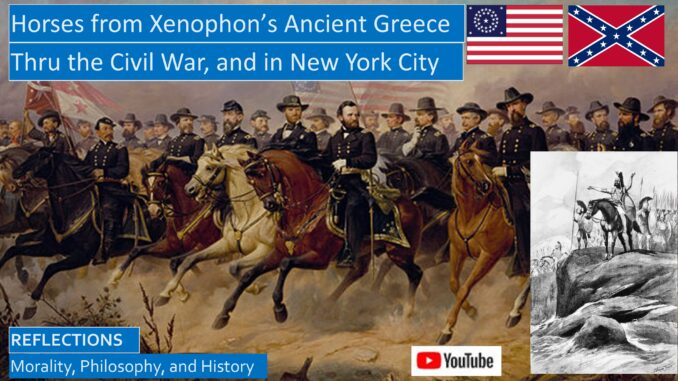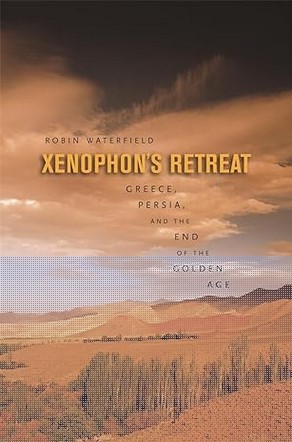
How were horses used in cavalry forces in warfare in both the ancient and modern world? How did cavalrymen battle the enemy while on horseback, or in chariots? Or did the cavalry dismount and fight like infantry on foot?
How did changes in technology affect how horses were used in battle?
What were the unique challenges faced when caring for horses during wartime?
Why were horses, not cars, seen as the major sources of pollution in big cities like New York City?
HOW HORSES WERE USED IN WARFARE
Horses were the major form of transportation before the invention of the automobile, and were used extensively in combat before the World Wars. We became interested in this topic when we found, in a collection of Civil War letters, a letter from a cavalryman describing how horses suffered and died during the Civil War. Also, in ancient Greece, Xenophon wrote several interesting treatises on horses and cavalry.
From antiquity, in combat, horses had three roles: hauling supplies, fighting in highly mobile cavalry regiments, sometimes pulling chariots in ancient times, and enabling generals to quickly survey the battlefield. From ancient times, in both war and peace time, technological improvements meant horses could be used more effectively. Improved harnesses made chariot warfare common throughout the Ancient Near East, quite often several archers would ride in the chariot.[1] In the Old Testament, we read that King Ahab died in battle when an arrow struck him in his chariot, likely he was standing next to an archer. [2]
The Greek and Trojan heroes rode chariots in the Iliad, several professors have quipped that Homer must not have known their original purpose, since they were used as ancient taxicabs to carry the heroes to the front line.[3] This may have been accurate, as Julius Caesar, when he invaded Britain, described British charioteers throwing javelins, then leaving their chariots to fight as infantrymen.[4] In the Iliad, Achilles also used his chariot to drag the corpse of the vanquished Trojan Prince Hector around the walls of Troy.
Summary of Homer’s Iliad: Warrior Culture of Ancient Greece
https://seekingvirtueandwisdom.com/summary-of-homers-iliad-warrior-culture-of-ancient-greece/
https://youtu.be/6C5znDxvpQ8
How did the ancient cavalryman fight? They could slash at infantrymen with their swords, or they could throw javelins, or stab with spears, or most difficult of all, they could fire arrows while at a gallop. These skills could take years of training and practice to master.
In the Cyropedia, the Education of Cyrus, Xenophon tells us that during his first hunt, Cyrus the Great eagerly pressed his horse to chase a great stag. His horse slipped, going to his knees, nearly throwing him, but “the boy managed to keep his seat, and the horse recovered its footing,” and shortly “Cyrus let fly his javelin, and the stag fell dead, a beautiful big creature.” When they were dismounted, admiring the slain stag, Cyrus sprang back on his horse when he heard a “frenzied wild boar charging down on them. He charged to meet it, drawing his bow with the surest aim possible, striking the beast in the forehead, and laid him low.” Cyrus would later display this brave coolness when under fire in battle.[5]
Xenophon’s Cyropaedia, Biography of Cyrus the Great, King of Persia
https://seekingvirtueandwisdom.com/xenophons-cyropaedia-biography-of-cyrus-the-great-king-of-persia/
https://youtu.be/E4BFSIpHHGk
So, Cyrus the Great, and possibly Cyrus the Younger, Xenophon’s patron, as well as the Mongol and Turkic horsemen and the American Great Plains Indians, could manage to shoot a bow and arrow on horseback.
Iliad, Blog 3, Visiting the Enemy Camp, Greeks vs Indians
http://www.seekingvirtueandwisdom.com/iliad-blog-3-visiting-the-enemy-camp-greeks-vs-indians/
The Warrior Cultures of the Iliad and the American Indian, Bravely Visiting the Enemy Camp
https://youtu.be/ynIx-AVI2f8
XENOPHON’S ON THE CAVALRY COMMANDER
Xenophon was an excellent horseman; he wrote a treatise On the Cavalry Commander. He may have been too young to fight in the Peloponnesian Wars, he may have served in the Athenian cavalry, but we can infer from his account in his Anabasis, The Expedition of Cyrus, that he had battlefield experience.[6]
Xenophon is fond of maxims, he teaches the moral lesson that we must be kind to our horses. “While the ranks are filling up, you must see that the horses get enough food to stand hard work, since horses unfit for their work can neither overtake nor escape. You must see that they are docile because disobedient animals assist the enemy more than their own side.” “And horses that kick when mounted must be got rid of, for such brutes often do more mischief than the enemy.”
How do you train the cavalry? Xenophon states that “having made sure that the horses are in good condition, the next business is to train the men. First, they must learn to mount from the spring, since many before now have owed their lives to that. Second, they must practice riding over all sorts of ground since any kind of country may become the area of war.”
Xenophon continues: “As soon as they have acquired a firm seat,” they “should be able to throw the javelin when mounted and become efficient in all the details of horsemanship.” “Both horses and men must be armed, so that, while they are themselves thoroughly protected against wounds, they may have the means of inflicting the greatest loss on the enemy.”
What are the duties of the cavalry commander? Most importantly, the commander “must seek to make the men obedient: otherwise, neither good horses nor a firm seat nor fine armor are of any use.”[7] Xenophon moralizes: “First, he must sacrifice to propitiate the gods on behalf of the cavalry; secondly, he must make the processions during the festivals worth seeing; further, he must conduct all the other obligatory displays” at public festivals “before the people with as much splendor as possible.”[8] “During a march, the cavalry commander must always think ahead, so he may rest the horses’ backs and relieve the men by walking, giving moderate spells of alternate riding and marching.”[9]
Xenophon closes with a moral lesson: “Therefore there is none other who can give counsel but the gods. They know all things, and warn whomsoever they will in sacrifices, in omens, in voices, and in dreams. And we may suppose that they are more ready to counsel those who not only ask what they ought to do in the hour of need, but also serve the gods in the days of their prosperity with all their might.”[10]
Xenophon followed this advice himself in his Anabasis, when he led the Ten Thousand Greek troops out of the heart of Persia. But if the seers inspecting the entrails of slaughtered animals discovered bad omens when Xenophon thought they should proceed, he demanded they try, try, try again until a good omen was produced.
Xenophon also wrote a treatise On the Art of Horsemanship. Dr Wikipedia informs us that many of his tips on purchasing, training, and care of horses are valuable to horse owners today.[11]
HORSES IN ANCIENT GREEK CAVALRY AND LOGISTICS
The modern historian Robin Waterfield has written an excellent account of Xenophon’s Anabasis, and he includes several interesting observations on how horses were used in the ancient Greek and Persian armies. In ancient battles, often the cavalry forces rode around the battle, flanking the enemy, sometimes attacking in the rear, seeking to cause panic among the enemy forces.
The Historian Robin Waterfield Reflects on Xenophon’s Anabasis in Persia, and Other Greco-Persian Conflicts
https://seekingvirtueandwisdom.com/the-historian-robin-waterfield-reflects-on-xenophons-anabasis-in-persia-and-other-greco-persian-conflicts/
https://youtu.be/sOZAKFfEnKw
Rarely would cavalry forces charge headlong into battle. Waterfield states that, in particular, the Greek “arms, armor, and tactics outclassed anything they faced, even the famous Persian cavalry: no horse, however passionately urged on by its rider, will hurl itself into a solid Greek Hoplite infantry phalanx, bristling with spears. In a tightly packed phalanx, the spears for the first three lines were long enough to project in front of the first line, if the soldiers had the necessary strength and skill. The most a horseman could do was ride up close enough to discharge a javelin, and even that was difficult to do effectively in the days before saddles and stirrups.”[12]
Robin Waterfield also describes the logistics of ancient armies. During Xenophon’s Anabasis, “Cyrus’ army was followed by thousands of carts, ranging from two-wheelers to six-wheelers,” filled with supplies of all sorts. “Packing and unpacking the wagon every day was a notoriously tedious aspect of a military campaign for those who lacked slaves to do the job.” “One well-stacked cart could be loaded with the arms, armor, equipment and tents for twenty men, and Cyrus’ men required fifteen hundred carts.”
Waterfield continues: “Pack animals and slaves were used as well as ox-carts for transport, and many soldiers also strapped a rucksack on their shoulders. Because of the amount of grain animals consume and the need to find campsites with sufficient fodder, individual human porterage was actually a highly efficient way for ancient armies to transport at least a portion of their equipment.” “The animals were generally expected to live off the land: fodder was not carried, and its availability was one of the main factors that decided a good spot for camping.”[13]
Both ancient and modern armies on campaign had to choose: Should they carry the supplies the armies needed, or should the armies setup up camp midday so they could forage and/or steal the provisions they needed? In Xenophon’s account of the Anabasis, or the Persian Expedition where Cyrus the Younger attempted to usurp the Persian throne, when the Greek mercenary armies marched through the arid southern approach towards Babylon, they were supplied by provinces friendly to Cyrus. When Cyrus was slain in battle, the Greeks were compelled to trudge north to the Greek colonies on the coast of the Black Sea. On this journey, they lived off the land, foraging and requisitioning the supplies they needed, ensuring the safety of the inhabitants if they voluntarily hosted the Greek army.
Xenophon’s Anabasis: The Persian Expedition, an Ancient Adventure Story
https://seekingvirtueandwisdom.com/xenophons-anabasis-the-persian-expedition-an-ancient-adventure-story/
https://youtu.be/DBG3JvyLP1E
Modern armies prefer to transport their own supplies, but Generals Grant and Sherman revived the ancient practice where their armies lived off the Confederate lands, particularly before Grant’s Siege of Vicksburg and during Sherman’s March to the Sea. This weakened the Southern economy, hastening the end of the Civil War.
Siege of Vicksburg: Ordinary Union Soldiers and Generals Grant and Sherman Recount the Struggle
https://seekingvirtueandwisdom.com/siege-of-vicksburg-ordinary-union-soldiers-and-generals-grant-and-sherman-recount-the-struggle/
https://youtu.be/U6KNO6IkVQs
Horses are not the only pack animals; mules are better pack animals than horses or donkeys. A mule is usually bred from a jack, or male donkey, and a mare, or female horse. Since donkeys and horses are differing species, with differing numbers of chromosomes, mules are usually sterile. Mules are hardier, more patient, and live longer than horses, and are less obstinate and more intelligent than donkeys.[14] Oxen were also used as pack animals, they were better at pulling wagons before improved horse harnesses were invented.[15]
CAVALRY IN MEDIEVAL EUROPE AND AFTERWARDS
The ancient Persians pioneered the use of armor for both horses and cavalrymen, as Xenophon stated. Both armor and chain mail protected medieval knights and their horses. As the armor became heavier, larger and larger horses were bred. The invention of the saddle and stirrup enabled knights to charge with lances, leading to the sport of jousting, where knights tried to unhorse their opponent.
Armored knights became obsolescent after the invention of the English longbow, and especially after the invention and perfection of firearms, leading to unarmored light cavalry. Elaborate turning movements were developed to maximize the effectiveness of using firearms from horseback. Often cavalry was used to combat enemy artillery, especially during deployment. And cavalrymen were still useful for scouting and reconnaissance.[16]
HORSES IN CIVIL WAR CAVALRY FORCES
How were horses used in the Civil War? Horses enabled officers to quickly determine the progress of the fighting across their front lines, and they pulled supply wagons. Quick raids by cavalry often surprised the enemy. During the Civil War, often cavalrymen dismounted upon arriving at their destination, fighting as infantry.[17]
General Ulysses Grant was fighting a war of attrition against the Confederate General Robert E Lee. In the last years of the war, whatever the outcome of a battle, the Union Army would immediately try to flank the Confederates to fight the next battle. This constant warfare exhausted the soldiers but was especially hard on the horses.
Captain Charles Adams of the Massachusetts Cavalry wrote home in 1863, describing how difficult it was to properly care for horses during the Civil War. “Do you know how cavalry moves? It never goes out of a walk, and four miles an hour is very rapid marching, ‘killing to horses,’ as we always describe it.” “You have no idea how the horses suffer.” “You are a slave to your horses,” “and you see diseases creeping on you day by day and your horses breaking down under your eyes.”
Our cavalryman continues, “I have but one rule: a horse must go until he can’t be spurred any further, and then the rider must get another horse as soon as he can seize on one.” How heavy is the burden they carry? “A cavalry horse, when loaded, carries an average of 225 pounds on his back,” and “a packed saddle alone weighs fifty pounds. The horse is, in active campaign, saddled about fifteen hours a day.” His feed is about eight pounds a day, which is too little, plus the grass he grazes during halts. “The usual water he drinks is brook water, so muddy by the passage of the column that it is colored chocolate.”
Our cavalryman says, “Imagine a horse with his withers,” or shoulders, “swollen to three times its natural size, and with a volcanic, running sore pouring matter down each side, and you have a case with which each cavalry officer is daily called upon to deal with, and you can imagine a horse which has still to be ridden until he lays down in sheer suffering under the saddle.” Every night, the first task of a cavalryman was to unsaddle his horse, examine the sores on his back, and do what he can to comfort and care for his horse.
Our cavalryman states that he had disabled ten horses by the constant campaigning over four months. He reports: “The air of Virginia is literally burdened today with the stench of dead horses, federal and confederate. You pass them on every road and find them in every field, while from their carrions you can follow the march of every army that moves.”
Our cavalryman remembers, “On our last raid, dying horses lined the road on which the Confederate divisions had passed, and we marched over a road made pestilent by the dead horses of the vanished rebels. Poor brutes! How it would astonish and terrify you and all others at home with your sleek well-fed animals, to see the weak, gaunt, rough animals, with each rib visible and their hip-bones starting through the flesh, on which these ‘dashing cavalry raids’ were executed.”[18]
During the Civil War, the Confederate officers supplied their own horses, which was also the predominant practice in both the ancient and medieval worlds. After the defeat of the Confederates at Vicksburg, and after the defeat of the armies of Robert E Lee at Appomattox, General Grant permitted the Confederate officers to keep their sidearms and horses, so they could use them in spring planting.
Civil War Struggle Through Paintings
http://www.seekingvirtueandwisdom.com/civil-war-struggle-through-paintings/
https://youtu.be/2hoBOSOBUP8
HOW HORSES WERE USED IN THE TWO WORLD WARS
The development of trench warfare, barbed wire, machine guns, and tanks made traditional cavalry obsolete. Cavalry charges on horseback were common early in World War I, and cavalry forces were used sporadically during World War II.
Horses were still used as pack animals by all sides in World War I, and by both the Germans and the Russians in World War II. The Germans used more horses in World War II than in World War I, its factories were dedicated to producing tanks and aircraft, and the Nazi armed forces were always short on fuel.[19]
Horses were sometimes used in challenging terrain in recent wars. For example, the American Special Forces accompanied the forces of Afghan warlords on horseback in the mountains of North Afghanistan.[20]
HORSES IN THE METROPOLIS OF NEW YORK CITY
We associate pollution with the automobile whose exhaust fumes that cover our cities, especially Los Angeles, with smog. But after automobiles were invented, they were eagerly adopted as the solution to a pressing problem: pollution caused by the thousands of horses trudging about in the cities, particularly New York City.
In the late nineteenth century, several hundred thousand horses pulled trolleys, carts, and carriages through the streets of New York City. Each horse dumped on the street thirty pounds of manure and a quart of urine each day. Annually, New York City had to dispose of over one hundred thousand tons of manure, and the carcasses of the fifteen thousand horses that died on the streets of New York annually.
At first, the surrounding farmers were happy to pay for manure to fertilize their fields, but after the volume became overwhelming, farmers charged to accept the manure. Workers gathered the manure in piles on vacant lots that were sixty feet high. Rain seeped into the manure, manure streams seeped into basements, the manure bred flies, and these thousands of flies spread diseases. Walking across the street was hazardous, you did not want to slip and fall!
The officials of New York City hired an army of sanitation workers, and built sewers and infrastructure to handle the ever-growing piles of horse manure, but to no avail. Finally, by 1912 cars outnumbered horses on the streets of New York City, and year by year, as the number of horses dwindled, so did piles of manure, and the stench.[21]
DISCUSSING THE SOURCES
This collection of the Civil War letters of mostly ordinary soldiers, but also of generals and the occasional letter from President Lincoln, revealed the concerns and thoughts of ordinary soldiers fighting in this epic struggle.
Robin Waterfield’s account of Xenophon’s Expedition, include excellent background information on the ancient culture and logistics of Greece and Persia. We quoted from Xenophon’s Cyropaedia, the Education of Cyrus, which may reflect the qualities he saw in his patron, Cyrus the Younger, who was slain fighting to usurp the throne of Persia.
Though he is deprecated by many haughty modern historians, in the ancient world Xenophon’s works were read as widely as were the works of Plato. One favorite was the Anabasis, his description of the Persian Expedition. This was also a favorite of King Philip of Macedon and his son, Alexander the Great, who were inspired by this work in their victorious invasion of Persia.
Xenophon’s Anabasis: The Persian Expedition, an Ancient Adventure Story
https://seekingvirtueandwisdom.com/xenophons-anabasis-the-persian-expedition-an-ancient-adventure-story/
https://youtu.be/DBG3JvyLP1E
[1] https://en.wikipedia.org/wiki/Horses_in_warfare
[2] https://www.biblegateway.com/passage/?search=1+Kings+22%3A29-40&version=RSVCE
[3] Professor Kenneth Harl of the Teaching Company/Wondrium, and Professor Donald Kagan of Yale University, they both lecture on the Peloponnesian Wars.
[4] https://en.wikipedia.org/wiki/Horses_in_warfare, footnotes 84 and 85.
[5] Xenophon, Cyropaedia, The Education of Cyrus, Book 1, Chapter 4, pp. 10-11.
[6] Robin Waterfield, Xenophon’s Retreat, Greek, Persia, and the End of the Golden Age (Cambridge, Massachusetts: Belknap Press of Harvard University Press, 2006), p. 37.
[7] Xenophon, On the Cavalry Commander, translated by EC Marchant and GW Bowersock, http://www.perseus.tufts.edu/hopper/text?doc=Perseus%3Atext%3A1999.01.0210%3Atext%3DCav., Chapter 1.
[8] Xenophon, On the Cavalry Commander, Chapter 3.
[9] Xenophon, On the Cavalry Commander, Chapter 4.
[10] Xenophon, On the Cavalry Commander, Chapter. 9.
[11] Xenophon, On the Art of Horsemanship, translated by EC Marchant and GW Bowersock, http://www.perseus.tufts.edu/hopper/text?doc=Perseus%3Atext%3A1999.01.0210%3Atext%3DHorse.
[12] Robin Waterfield, Xenophon’s Retreat, p. 3.
[13] Robin Waterfield, Xenophon’s Retreat, pp. 105-107.
[14] https://en.wikipedia.org/wiki/Mule
[15] https://en.wikipedia.org/wiki/Ox
[16] https://en.wikipedia.org/wiki/Horses_in_warfare
[17] https://en.wikipedia.org/wiki/Battle_of_Brandy_Station
[18] Civil War Letters, From Home, Camp & Battlefield, edited by Bob Blaisdell (Mineola, NY: Dover Publications, 2012), pp 117-119.
[19] https://en.wikipedia.org/wiki/Horses_in_World_War_I and https://en.wikipedia.org/wiki/Horses_in_World_War_II
[20] https://en.wikipedia.org/wiki/Horses_in_warfare, footnotes 211-213.
[21] https://www.newyorkalmanack.com/2021/02/the-unpleasant-side-of-life-with-horses-in-cities/ and








Be the first to comment